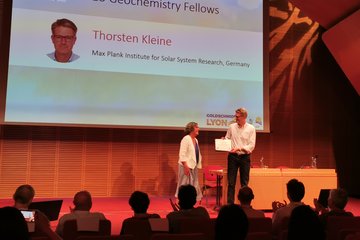Alle Typen
241.
Konferenzbeitrag
Coronal heating by transition region reconnection. In: Proc. of the SOHO15 ``Coronal Heating'' Workshop, 6-9 September 2004, S. 23 - 28 (Hg. Ireland, J.; Walsh, R. W.). ESA Publ. Div., Noordwijk (2004)
242.
Konferenzbeitrag
3D Vlasov-code simulations of instabilities of thin current sheets. In: Proc. XXVI International Conference on Phenomena in Ionized Gases, S. 35 - 50 (Hg. Meichsner, J.; Loffhagen, D.; Wagner, H.-E.). University Greifswald, Greifswald (2003)
243.
Konferenzbeitrag
SCHWARM - Microsatellite formation flying in the Earths's magnetosphere. In: Proc. Second International Workshop on Satellite Constellations and Formation Flying (Hg. Guelman, M.). Asher Space Research Institute, Technion City, Haifa (2001)
244.
Konferenzbeitrag
Die Einkopplung solarer Energie über die Magnetosphäre. In: Proc. National Space Weather Workshop, S. 5 - 14 (Hg. Adrian, D.; Jakowski, N.; Wehrenpfennig, A.). DLR, Neustrelitz (2000)
245.
Konferenzbeitrag
Numerical simulations for CLUSTER tested with EQUATOR-S and GEOTAIL. In: Cluster-II Workshop: Multiscale/Multipoint Plasma Measurements, S. 219 - 226 (Hg. Harris, R. A.). ESA Publ. Div., Noordwijk (2000)
246.
Konferenzbeitrag
Turbulent boundarry layer as a source of the accelerated ionospheric particles. In: Proceedings of the Second Alfven Conference, S. 123 - 128. (2000)
247.
Konferenzbeitrag
Methods of small-scale multi-satellite measurements for project Roy. In: Cluster-II Workshop: Multiscale/Multipoint Plasma Measurements, S. 249 - 256 (Hg. Harris, R. A.). ESA Publ. Div., Noordwijk (2000)
248.
Konferenzbeitrag
SCHWARM - a swarm of small spacecraft to study plasma turbulence and magnetic field annihilation. In: Proc. 14th ESA Symposium on European Rocket and Balloon Programmes and Related Research, Potsdam, Germany, 31st May - 3rd June 1999, S. 615 - 620 (Hg. Kaldeich-Schürmann, B.). ESA Publ. Div., Noordwijk (1999)
249.
Konferenzbeitrag
Substorms: a global magnetospheric instability. In: Substorms-4, S. 231 - 235 (Hg. Kokobun, S.; Kamide, Y.). Terra Scientific Publishing Company, Kluwer Academic Publishers, Dordrecht, London, Boston, Tokyo, Japan (1998)
250.
Konferenzbeitrag
Kinetic effects controlling the onset of 3-D tail reconnection large scale coherent reconnection. In: Substorms-4, S. 461 - 466 (Hg. Kokobun, S.; Kamide, Y.). Terra Scientific Publishing Company, Tokyo, Kluwer, Dordrecht (1998)
251.
Konferenzbeitrag
Newly developed 3D PIC code and its application to reconnection. In: Proc. Fifth Int. School/Symp. for Space Simulations (ISSS-5), S. 186 - 189. Kyoto University, Kyoto (1997)
252.
Konferenzbeitrag
New results about the cause of sudden magnetic detachments by three-dimensional spontaneous magnetic reconnection. In: Proc. 31st ESLAB Symp. ``Correlated Phenomena at the Sun, in the Heliosphere and in Geospace'', ESTEC, S. 131 - 138 (Hg. Wilson, A.). ESA Publ. Div., Noordwijk (1997)
253.
Konferenzbeitrag
Remote sensing of reconnection by multipoint particle observations in the Earth's magnetotail. COSPAR Information Bulletin, S. 211 - 216 (1995)
254.
Konferenzbeitrag
Simulation of macroscopic signatures of microscopic chaos. In: Proc. 4th International School forspace simulation, Nara, April 1991, S. 75 - 77. University of Kyoto Press, Kyoto, Japan (1991)
255.
Konferenzbeitrag
Chaos and tearing mode instability. Geophysical Research Letters, S. 385 - 388 (1991)
256.
Konferenzbeitrag
Energetic particles in the magnetotail or: CLUSTER and REGATTA as a dispersiometer. In: Proc. Int. Workshop on Space Plasma Physics Investigations by CLUSTER and REGATTA, S. 117 - 125. ESA Publications Division, Noordwijk, The Netherlands (1990)
257.
Vortrag
Collisionless magnetic reconnection in the solar corona. Colloquium Instituto Superior Tecnico, Lisboa, Portugal (2015)
258.
Vortrag
Electron Energization in the Solar Corona in Current Concentrations and by Magnetic Reconnection. 14th Annual International Astrophysics Conference, Tampa, USA (2015)
259.
Vortrag
Models and Data Driven Simulation of Solar Eruptions. Turbulence, magnetic fields and self organization in laboratory and astrophysical plasmas, Princeton, USA (2015)
260.
Vortrag
Electron shear flow instabilities and electromagnetic fluctuations in collisionless magnetic reconnection. Max Planck Princeton Center for Plasma Physics (MPPC) , Göttingen, Germany (2015)











